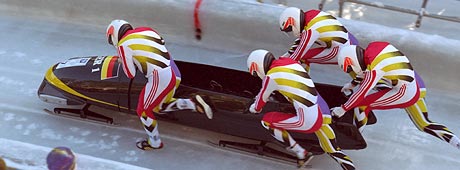
Olympic bobsledding. 1/1000th of a second from winning or loosing.
“When you reach for the stars, you may not get one, but you won't come up with a handful of mud, either.”
Author unknownOlympic Bobsledding had it’s very beginning in 1877 in Davis, Switzerland after people tried adding a steering wheel to a sled. In 1897 a club was formed in St. Moritz, Switzerland.
At that time most of the bobsled runs were only on the roads and proved to be a great winter pass-time of the wealthy. It was as popular as skiing is today. It is said that they called it bobsledding because the team members bobbed their heads to try to gain speed.
Olympic bobsledding found its way into the winter games in 1932. Women were not included as four man teams entered the competition. Two man teams were added later. The sport was a no-no for women until the 2002 games in Salt Lake City. Strangely, the only winter games where Olympic bobsledding were not held occurred in the 1960 games in Squaw Valley, California due to lack of interest.
Bobsledding, Luge and skeleton are three distinctly different sports.
Olympic bobsledding begins with two or four person teams pushing the sled along the track to get a start and climbing in.
A luge race begins with the single person pushes off from two bars sitting on the sled with the feet facing forward.
In skeleton racing, the rider pushes his sled down along the starting area, and barrels down the track head first.
The Team
Three things are required for the bobsled race. A team, a bobsled and a track. The team is made up of two or four person teams who must steer, brake and give the weight to the overall weight of the bobsled. The bobsled has been designed to aerodynamically cut through the air as it makes its way on the ice. The runners are extremely smooth to help with the speed.
At the first, the tracks were simply made from piled snow. Later the ground would be coated with ice. Now the bobsled run is made of concrete. Inside the concrete are miles of pipes filled with a solution of chemicals that help the ice making plant to freeze the water as it is flooded. Slowly the expert ice makers build up a surface of solid ice to allow the sleds to hit speeds of upwards of 130 km (78 miles) per hour. Crashes are common.
Olympic bobsledding requires the team members to have a great sense of balance and they must be brave. But a lot more than that goes into the run to the bottom. The sleds weigh hundreds of pounds and to get them started with a bang the team must be very strong and fast. They must get it going, run as fast as they can and then get inside in a matter of seconds, smoothly. Coordination is the key.
Team members will probably come from a background of sports such as football or track and field where strength and agility are the keys.
Start Shoes
The team member need plenty of traction to be able to push the heavy bobsled. Olympic bobsledding is a demanding sport. Everyone on the team must wear spiked shoes. The spikes are arranged to provide the best traction and they can’t be longer than one millimeter in length. They must be no wider than four millimeters and no further apart than three millimeters.
Tobogganing What a fantastic fun thing to do. Totally different from bobsledding.
Suits
The bobsledders suits are wild. Fantastic graphics. Colorful and skin tight. The colors and graphics do not do much but the suite are designed to assist drag resistance from the air.
Helmets
Helmets get wilder and more aerodynamically designed every year. They and everything worn or used is designed with the assistance of a wind tunnel. Most drivers wear gloves for better grip.
Here is how serious the teams go about an attempt to win. Because a bobsled can cost over $25,000. to build, a company called Sports Biomechanics Lab at the university of California at Davis, built a bobsledding simulator. It used physics and complex mathematical equations to recreate the experience of Olympic bobsledding.
For all of the events check out these Olympic sports events.
Speed skating Power and agility on skates.
Figure Skating Beauty and grace on ice.
Alpine skiing. Racing the clock.
Bobsleds. see how they are constructed.
Nordic skiing. Exciting races on skinny skis.
Biathlon Nordic skiing and rifle shooting combination.
Curling. The ancient game just gets better.
Hockey High flying teamwork in action.
Luge. How fast will the sled go.
Ski Jumping.Soaring through the air like a bird.
Freestyle Skiing. daring acrobats on skis.
Bobsledding. Learn the technique with this interactive site.
Return from Olympic Bobsledding to Whistler Outdoors



